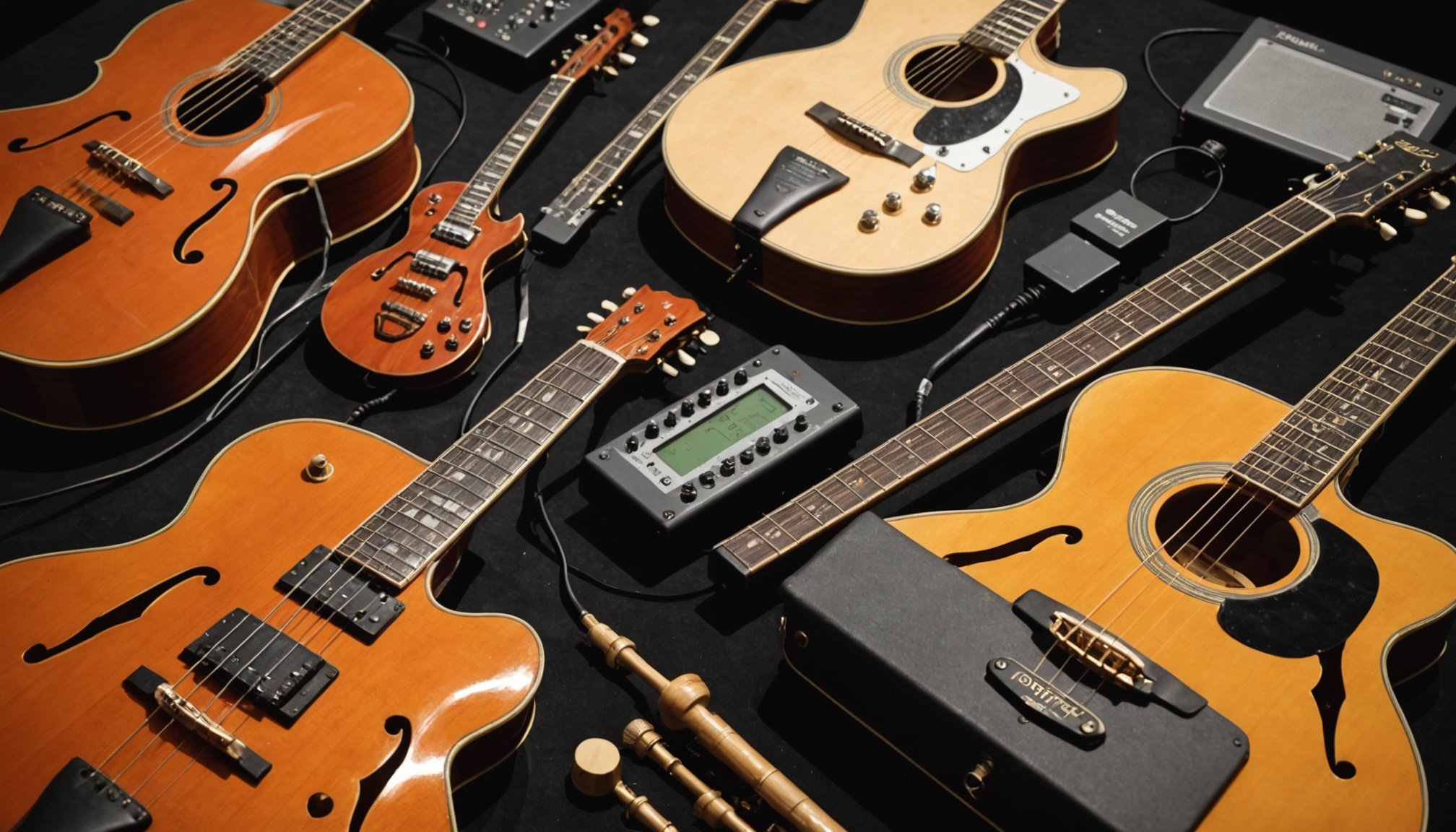Understanding Humidity’s Impact on Musical Instruments
Humidity plays a critical role in the deterioration of musical instruments, and understanding its effects is essential for their preservation. Both wooden and metal instruments can suffer from climate challenges, which often manifest as cracks, warping, or corrosion due to humidity fluctuations.
For wooden instruments, such as guitars and violins, changes in humidity levels can lead to expansion and contraction, ultimately causing structural damage like cracks or seam separation. Metal instruments, like trumpets and saxophones, may develop tarnishing or corrosion when exposed to excessive moisture.
Lire également : Discover the Best Methods for Efficiently Recycling Small Electronics in the UK
Common symptoms of humidity-related damage include changes in sound quality and playability. Wood may warp, affecting the tone, while metal components may seize or become harder to operate.
Maintaining optimal humidity levels is crucial to prevent such damage. A consistent environment, ideally between 40-60% humidity, helps to keep various instrument types in good condition. Using a humidifier or dehumidifier can help in maintaining these levels, mitigating risks associated with climate fluctuations. Proper care and monitoring can significantly extend the lifespan and quality of musical instruments, preserving their sound and appearance for years to come.
Cela peut vous intéresser : Top Air Purifiers to Combat Pollen Allergies in UK Homes: Discover the Most Effective Models
Recommendations for Humidity Regulation Solutions
Musical instruments require careful climate control to maintain their condition and performance. Finding the right humidity control products is crucial for preserving your instruments. Below, we delve into some top dehumidifiers and humidifiers that are perfect for instrument care.
Best Dehumidifiers for Musical Instruments
Selecting the proper dehumidifier is essential for protecting musical instruments from moisture damage. In the UK, several dehumidifiers stand out due to their high ratings and effectiveness. These dehumidifiers are known for their capacity to extract excess humidity, safeguarding delicate materials like wood.
- Key features to consider include size, portability, and the ability to maintain a consistent environment.
- In terms of cost-effectiveness, energy-efficient models with adjustable settings are preferable as they reduce operational costs while maintaining optimal conditions.
Effective Humidifiers for Instrument Preservation
For humidifiers, the focus shifts towards adding much-needed moisture to the air, especially in drier climates or during harsh winters. Best humidifiers for musicians are those that maintain stable humidity levels without causing excess dampness.
- Exploring specifications and benefits like water capacity, mist output, and coverage area can enhance your selection process.
- A comparison between portable versus whole-home systems is crucial to determine whether a localized or comprehensive approach suits your needs best.
Climate-Controlled Cases and Storage Solutions
Investing in climate-controlled cases is another effective measure. These cases provide an added layer of protection by regulating internal environments. The importance of meticulous maintenance cannot be overstated, as regular monitoring ensures your instrument is always within safe humidity levels.
- Prospective buyers should consider top brands available in the UK that offer reliability and longevity in their products.
- Ensuring proper case care, such as cleaning and monitoring humidity with built-in sensors, plays a pivotal role in preserving your instruments.
Monitoring Humidity Levels
Keeping an eye on humidity levels is crucial for anyone involved in music, especially in maintaining the quality of instruments. Various humidity monitors, or hygrometers, are available to ensure you’re constantly informed.
Types of Hygrometers
There are digital and analog hygrometers. Digital hygrometers provide precise readings and often come with additional features like temperature displays and data logging. Analog hygrometers rely on mechanical sensors and are admired for their simplicity and elegance.
Recommended Hygrometers in the UK
For musicians in the UK, it’s beneficial to choose a hygrometer designed to handle the country’s humid climate. Popular options include the ThermoPro TP50 digital hygrometer, valued for its accuracy, and the Springfield Precision hygrometer, preferred for classic design and reliability.
Best Practices
Regular monitoring is essential. Place your hygrometer in the same room as your instruments to ensure consistent readings. Ideally, aim for a relative humidity of 40-60%. If levels deviate, using humidifiers or dehumidifiers can help maintain the optimal range. Checking your hygrometer frequently and adjusting your room conditions as needed ensures your instruments remain in peak condition.
Care Tips for Musical Instruments by Type
Caring for musical instruments ensures their longevity and performance. Tailoring maintenance to each instrument type is paramount. The following guidance provides effective instrument care strategies to safeguard your prized possessions.
String Instruments Care
String instruments, such as violins and cellos, require specific humidity requirements. Ideally, maintain humidity levels between 40% and 60%. Ensuring this range prevents the wood from cracking or warping. Preservation strategies involve regular polishing and protecting strings from sweat and oils. Use a soft, dry cloth after playing to wipe down strings and wood surfaces. Recommended products for strings include string conditioners and rosin to maintain tone quality.
Woodwind Instruments Care
Humidity control in woodwind instrument care is essential. Keep them in a stable environment with humidity around 45% to 55%. Proper maintenance tips involve regular inspection of pads, as they affect the instrument’s sound. Replace worn-out pads promptly. Use mild soap and a soft brush for cleaning the exterior. It’s vital to clean the mouthpiece frequently using non-abrasive products.
Brass Instruments Care
Brass instruments thrive in environments where humidity levels remain consistent, typically around 30% to 50%. Cleaning routines every three months are crucial. Regular maintenance includes removing debris using a snake brush. Applying valve oil improves performance. Preserving brass involves using recommended lubricants like slide grease to ensure smooth operation.
Comparisons of Humidity Control Solutions
When seeking humidity control solutions, understanding solution effectiveness is crucial. Products vary widely, so product comparisons enable informed decisions. Devices such as dehumidifiers, humidifiers, and hygrometers each serve unique purposes. For example, the effectiveness of a dehumidifier in a small, damp room can differ significantly from that in a large, airy space. Evaluating the right tool involves understanding your specific needs.
UK musicians often emphasize the importance of maintaining, for their instruments, an optimal 40-60% humidity range. Recipient reviews from these users reveal diverse experiences with different products. Some preferred mini humidifier solutions for their affordability and ease of use, while others appreciated the power and solution effectiveness of more complex systems.
In terms of cost versus effectiveness, many users find that investing in a high-quality humidity control device pays off long-term, particularly when protecting valuable or sensitive items. For example, while a premium humidifier might seem costly upfront, its ability to maintain constant humidity can far outweigh initial expenses. Carefully weighing user feedback, potential investment, and solution effectiveness can guide you to choose the most appropriate humidity control method for your needs.











